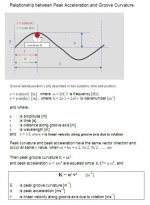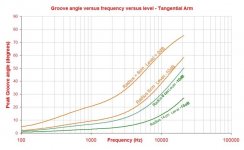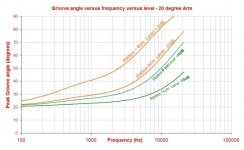jcx Thank you for the links. I appreciate your trying to help me understand.
I was able to read the second link, but was not very impressed. I saw assertions made with great confidence, but, unless I have altogether forgotten about Fourier Transforms, were wrong. In any case, assertions made without justification - what mathematicians call "hand-waving". At present, I stand by my earlier posting.
CS, I would like to review anything which you think is definitive.
I was able to read the second link, but was not very impressed. I saw assertions made with great confidence, but, unless I have altogether forgotten about Fourier Transforms, were wrong. In any case, assertions made without justification - what mathematicians call "hand-waving". At present, I stand by my earlier posting.
CS, I would like to review anything which you think is definitive.
I think it is like videocard algorithym to reduce jaggies. Waveform in digital mode is steep zero ramped stairstep. We add tubes to smear that out some.
The needle form as well as the limits of manufacturing process, act like a cam profile. Physics dictates how fast the ramp can be, and that being dictated by compliance and weight on needle.
So, needles and grooves are a smooth waveform. With a transition from one to another peak that is not purely vertical.
It seems that this also could be put in box form. Perhaps even analogous to the videocard technology.
The needle form as well as the limits of manufacturing process, act like a cam profile. Physics dictates how fast the ramp can be, and that being dictated by compliance and weight on needle.
So, needles and grooves are a smooth waveform. With a transition from one to another peak that is not purely vertical.
It seems that this also could be put in box form. Perhaps even analogous to the videocard technology.
.....Aren't humans fascinating?....
(off topic observation!)
That's why the Aliens are watching us but not interacting with us ! 🙂
The madness is probably too frightening but interesting to watch from a distance ! Wonder if any other species kills each other in all kinds of gory ways ! We even invent chemicals and machines to make the event as terrible as possible ......when ( if required) it could have been done painlessly in a fraction of a second! 😱
You bet humans have superb 'imagination' !
Yes, that is a measurement method to determine cartridge output slew rate, and so determine recorded/playback stylus acceleration.Lucky you’ve written this in the past (attached)
George
In principle one could do that measurement for a rip too, so long as it is made without RIAA compensation. Or, for a rip, one can simulate it as per my post on this thread so long as one removes RIAA comp from the rip or from the sim.
Here's some more of my stuff showing the relationship between groove curvature and acceleration, and how curvature is then related to the linear velocity with an inverse square law. This is one reason why inner groove playback can become difficult rapidly as the playback radius (and so linear velocity) decreases toward the inner grooves.
Also attached are some plots showing calculated results of how groove angle varies with programme level, frequency and inner radius - taking into account the effect of RIAA precomp. IIRC, red is for 33rpm, green is for 45rpm in the first plot.
Two plots are shown, one for a tangential arm and one for an offset arm showing the significant benefit as to tangential arms when one considers the angle presented to the line of friction force which always acts through the pivot.
In practice, an offset angle of about 40 deg is the practical trackability limit IME, and it's rare to find recordings with more than 600G acceleration/curvature IME - 300-400G is more common for most programme material.
Hope this makes some sense to someone other than me !
Attachments
I think this is a very good point.
Hmmm.
Adding pre-echo to a CD signal is going to be tricky unless we use a digital delay of at least a second or two on the main signal. Once the delayed main path reaches a decent volume, the pre-echo signal could be discretely faded away to nothing to preserve the famous clarity of digital signals.
Call that a fiddle if you like, but I think it would work...
Gosh, I haven't thought of this effect in a long time - haven't had a turntable set up here in ages. Along with the initial stylus thump, that little (sometimes not-so-little) pre-echo could definitely induce a palpable feeling of anticipation, and of course it could also be heard at other points on some records. Certainly another credible item for the vinyl nostalgia list.
If you're serious about trying to recreate it, you should probably examine the relative spectra of some actual vinyl pre-echos - you'll want to emulate not only the reduced level but also the muffled sound. 🙂
-- Jim
Waveform in digital mode is steep zero ramped stairstep. We add tubes to smear that out some.
... and another one, bingo!
The stairstep is not the output signal, it is not what you listen to. There's some stuff after that, and after THAT it is what you listen to. And, lo and behold, that's just as smooth as the vinyl signal. Actually more smooth, come to think of it.
Jan
Gosh, I haven't thought of this effect in a long time - haven't had a turntable set up here in ages. Along with the initial stylus thump, that little (sometimes not-so-little) pre-echo could definitely induce a palpable feeling of anticipation, and of course it could also be heard at other points on some records. Certainly another credible item for the vinyl nostalgia list.
If you're serious about trying to recreate it, you should probably examine the relative spectra of some actual vinyl pre-echos - you'll want to emulate not only the reduced level but also the muffled sound. 🙂
-- Jim
Mike Uwins in his study also needed to manipulate the digital replay in such a way that it wasn't immediately clear that it wasn't coming off vinyl. He added some groove noise, in particular at the start of the piece. That was enough to avoid all clues to the fans.
Jan
(off topic observation!)
That's why the Aliens are watching us but not interacting with us ! 🙂
The madness is probably too frightening but interesting to watch from a distance ! Wonder if any other species kills each other in all kinds of gory ways ! We even invent chemicals and machines to make the event as terrible as possible ......when ( if required) it could have been done painlessly in a fraction of a second! 😱
You bet humans have superb 'imagination' !
At the risk of skirting the rules: if we are so efficient in killing, why can't we cleanly and painlessly kill when we decide to kill as punishment? Is there a subconscious desired to make the f*cker (m/f) suffer as much as possible?
Jan
As the beatles are being discussed a lot, its worth pointing out that mono was the correct way of listening to them and that that albums were cut (and recut) until they would play on a cheap dansette with a completely shagged out stylus without skipping. They were chasing playability rather than fidelity!
Vinyl can sound much better than it's CD counterpart or even hi res digital. There of course is no general rule, but there is definately something that happens on great well done vinyl that sounds even more transparent than its digital part. I think in part some of its limitations force the mixing or mastering engineer to create a sonically more appealing master, there are a few notables who will tell you this, and I partially agree. For example you can't cut insanely bright highs and wildly sibilant vocals and have a good playback, this forces some degree of smoothness of the finished part on the masterig engineer, which equates to less fatigue on the ears. And to a different extent depending largely on the years, early a/d converters sucked big time by today's standards!.
Colin
Colin
Though it is a good idea to make a preamplifier handle the click/scratch generated signals cleanly. There is some evidence that slewing can exaggerate surface noise.....In practice, an offset angle of about 40 deg is the practical trackability limit IME, and it's rare to find recordings with more than 600G acceleration/curvature IME - 300-400G is more common for most programme material.
Hope this makes some sense to someone other than me !
edit
I have measured 200mV pk to pk, ringing at 19kHz from a G1022 hitting a defect
Last edited:
A common story is that in the mid sixties when stereo versions were first being mixed, they were done after the mono version was finalised and the band had gone homeAs the beatles are being discussed a lot, its worth pointing out that mono was the correct way of listening to them and that that albums were cut (and recut) until they would play on a cheap dansette with a completely shagged out stylus without skipping. They were chasing playability rather than fidelity!
Yes - there's a big difference between intentional programme content and unintentional clicks and pops as to acceleration and velocities (ie slew rates and levels). Programme material shows little difference between vinyl & digital as to levels and slew rates as a rule IME, whereas pops/clicks can often be massively above nominal FS and only crop up in vinyl of course. Not only does the phono preamp have to cope e,g recover promptly from saturation, but the stylus/arm also has to recover its location and recover normal trackability promptly. The cart/arm resonant system is not only displaced by pops/ticks, but also by momentary variation in friction force , at least in an offset arm, even when no mistracking or click/pop sounds. The upshot is a very subtle vibrato that doesn't happen in CD but pretty much always does in vinyl.Though it is a good idea to make a preamplifier handle the click/scratch generated signals cleanly. There is some evidence that slewing can exaggerate surface noise
I'd believe that ! 19kHz could be cantilever flex resonance, bending like the Tacoma bridge in response to the impossible task of hitting the defect ? The cart/arm resonance should also respond, c 10Hz or so.edit
I have measured 200mV pk to pk, ringing at 19kHz from a G1022 hitting a defect
A common story is that in the mid sixties when stereo versions were first being mixed, they were done after the mono version was finalised and the band had gone home
UK mixes were all mono (hence the recent mono re-release vinyl gouge set). Damned colonials insisted on stereo for some reason 😛. Mono is the correct way to listen to the beatles.
The 19kHz mechanical resonance is the challenge, especially for the "passive equalisation" designsI'd believe that ! 19kHz could be cantilever flex resonance, bending like the Tacoma bridge in response to the impossible task of hitting the defect ? The cart/arm resonance should also respond, c 10Hz or so.
Hope this makes some sense to someone other than me !
Thank you lucky. They do make sense to some here.
What modulation velocity you consider as 0dB at these diagrams?
You may be aware of Jim Lesurf’s three (>edit: four) first articles under “HFN-2008” heading
Jim's Audio Pages and Websites
See also some good programs by Keith Howard
Freeware
George
Thanks George. 5cm/S for 0dB level.What modulation velocity you consider as 0dB at these diagrams?
Yes, I'm aware of JL's articles which are well intended, but IIRC sometimes appear based on impossible levels, angles curvatures etc - perhaps for effect. They prompted me to work out my own geometry for the whole thing, and as result I obtain different key conclusions, esp as to recorded accelerations/curvature. But the spirit is great, and it gets one thinking.
Yes, Keith H's stuff as to geometry is good IMO. However, often inner groove sonic performance is not about Harmonic Distortion which is a geometric certainty, rather it is typically about geometric limits of trackability which is relatively unexplored and only a 2nd cousin of HD.
- Status
- Not open for further replies.
- Home
- Source & Line
- Analogue Source
- Hypothesis as to why some prefer vinyl: Douglas Self


